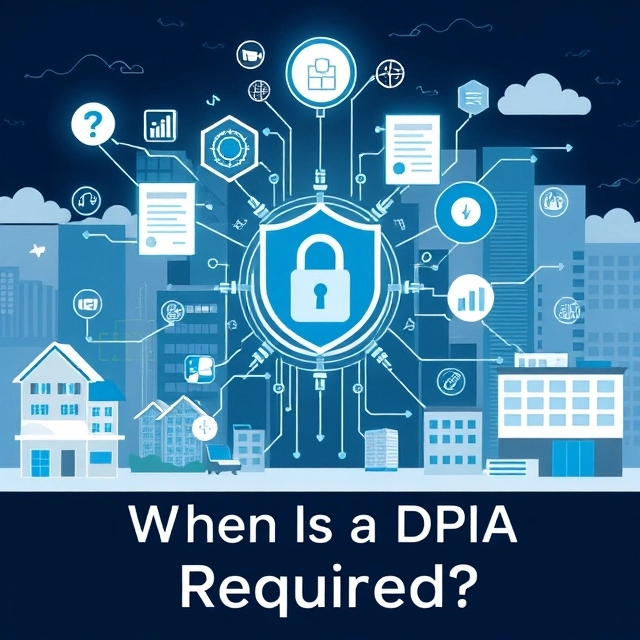
When Is a DPIA Required?
Table of Contents
ToggleWhen Is a DPIA Required? Key Insights for Real Estate Professionals
Having once shifted into data dependence in today’s real estate market, personal data hence became a valuable commodity. Across clients’ accounts, tenant vetting to other services that organizations in this sector may be conducting, handling large volumes of information is quite common. Since the GDPR came into force, data protection rules have been tightened, so no organization can cope with the job without the DPIA. But how do you know when is a DPIA required, and what qualifies as DPIA requirements for a real estate professional? So, let me present something new to you, closest to your separate industry perspective.
What Is a DPIA?
A DPIA is a structured process aimed at assessing the potential risks related to personal data processing activities. It is particularly relevant when data processing is likely to result in a high risk to the rights and freedoms of individuals. The assessment helps organizations identify risks and implement measures to mitigate them.
Why do DPIAs Matter for Real Estate?
Imagine this: you are a property manager and your new system of tenant screening does credit check and creates a profile on applicants. It is effective but raises the question, Is it legal? What should be assessed as the GDPR’s most important rule stipulates that where data processing poses a high-risk to the rights and freedoms of individuals, a DPIA must be conducted. For real estate professionals this means risk evaluation in cases such as large scale tenant data processing, integrated AI-based pricing or property surveillance.
DPIAs are not mere legalities, they are protection against monetary repercussions and such things as loss of reputation.
The Turning Points: When Is a DPIA Required?
While there is no simple checklist, not every form of data processing will need DPIA either. Some operations that occur in real estate remain relatively safe while others constitute activities that are problematic and pose high risk. Here are key instances:
1. Smart Building Technologies
Applications of IoT in facilities include smart lock/keyless entry, energy management, and facial recognition entrances, which are applied to most systems; this kind of technology collects and archives data about the residents. A DPIA guarantees these systems optimize between innovation and privacy.
2. Surveillance Systems
Security installation in people’s homes or workplaces, through cameras or locators affects the privacy of an individual. If such systems monitor people in a systematic manner, then a DPIA is required.
3. Automated Decision-Making
Delayed Payment tools that work as a way of determining the rental eligibility involvement of a tenant are in most cases subject to a DPIA. While these systems will impact the rights of the applicants they must undergo checks for bias and ad hoc policies.
4. Large-Scale Marketing Campaigns
As you work with very large datasets for the newsletters or market analysis, you can process personal data. A DPIA is used to uncover risks that may include data loss or use of the data in a wrong way.
Steps to Conduct a DPIA
Carrying out DPIA requirements isn’t as complex as it may seem. Here’s what you need to cover:
Step 1: Identify the Need for a DPIA
Determine if the planned data processing activity meets the criteria outlined in GDPR Article 35. Focus on activities involving high-risk scenarios.
Step 2: Describe the Data Processing
Provide a detailed explanation of how personal data will be collected, stored, used, and shared. Include specifics about data types and the purpose of processing.
Step 3: Assess Necessity and Proportionality
Evaluate whether the data processing is necessary to achieve the intended purpose. Ensure the methods used are proportionate and minimize data collection.
Step 4: Identify Risks
Analyze potential risks to individuals’ rights and freedoms. Risks may include unauthorized access, data breaches, or misuse of data.
Step 5: Define Mitigation Measures
Outline steps to reduce identified risks. These may involve encryption, access controls, or anonymization of data.
Step 6: Consult Stakeholders
Engage with key stakeholders, including data subjects, legal advisors, and IT specialists, to gain insights and ensure comprehensive risk evaluation.
Step 7: Document the DPIA
Maintain a detailed record of the DPIA process, including findings, risk mitigation measures, and consultation feedback.
Step 8: Review and Update
Regularly review the DPIA to ensure it remains relevant, especially when introducing new data processing activities.
Consequences of Not Conducting a DPIA
Failing to conduct a DPIA when required can result in severe consequences:
- Regulatory Fines: Non-compliance with GDPR can lead to fines of up to €20 million or 4% of global turnover, whichever is higher.
- Legal Issues: Organizations may face lawsuits for violating privacy rights.
- Reputation Damage: Trust can be eroded if clients perceive data mishandling.
- Operational Risks: Lack of risk assessment may lead to data breaches and security incidents.
Tools and Resources for Conducting a DPIA
Real estate professionals can use various tools to simplify the DPIA process:
- Templates: Pre-designed DPIA templates streamline documentation.
- Software Tools: Tools like OneTrust or TrustArc assist in automating assessments.
- Guidelines: Resources from data protection authorities provide step-by-step guidance.
- Training: Online courses help teams understand DPIA requirements.
Building Trust, One DPIA at a Time
For real estate professionals, DPIAs are more than a compliance requirement—they’re a tool to build trust in a competitive market. By proactively addressing data privacy risks, you position your business as both secure and customer-centric.
So, the next time you implement a new technology or launch a data-driven initiative, ask yourself: Is a DPIA required? If the answer is yes, embrace the opportunity to protect your business and your clients. After all, in real estate, trust and transparency are everything.
FAQs: When Is a DPIA Required?
Q: What triggers the need for a DPIA in real estate?
A: High-risk data processing activities, such as surveillance or automated decision-making, require a DPIA.
Q: Who is responsible for conducting a DPIA?
A: The data controller, typically the business or individual processing the data, is responsible.
Q: How long does a DPIA take?
A: The time required depends on the complexity of data processing but generally ranges from a few days to several weeks.
Q: Can a DPIA be conducted for existing processes?
A: Yes, DPIAs can be retroactively applied to assess ongoing data processing activities.
Q: Are DPIAs mandatory under GDPR?
A: Yes, in situations involving high risks to individual rights and freedoms.
Conclusion: When Is a DPIA Required?
A DPIA is an essential tool for real estate professionals to ensure data protection compliance and mitigate risks associated with personal data processing. By understanding when and how to conduct a DPIA, businesses can protect their clients’ privacy, avoid legal penalties, and build trust in their services. Incorporating a structured approach to data protection helps the real estate sector thrive in a privacy-conscious environment.
You May Also Like

The Ultimate Collection of Virtual Office Backgrounds
27 March 2025
Aircon Services: Keeping Your AC Efficient
4 January 2025

